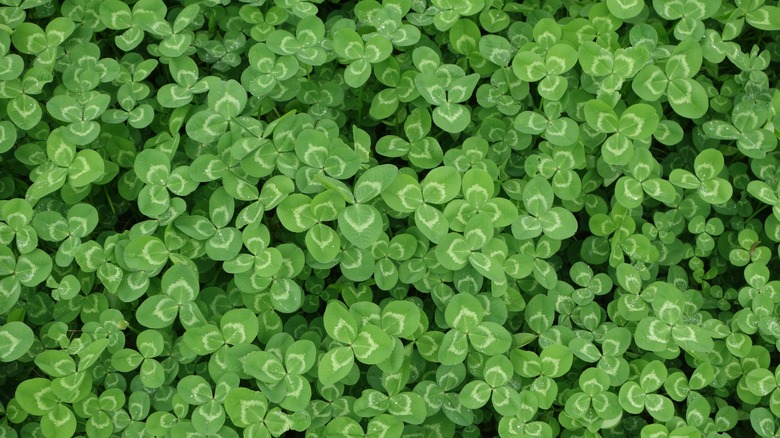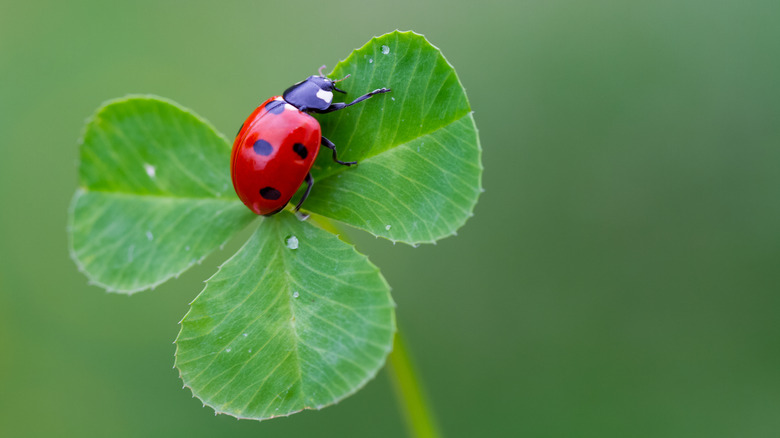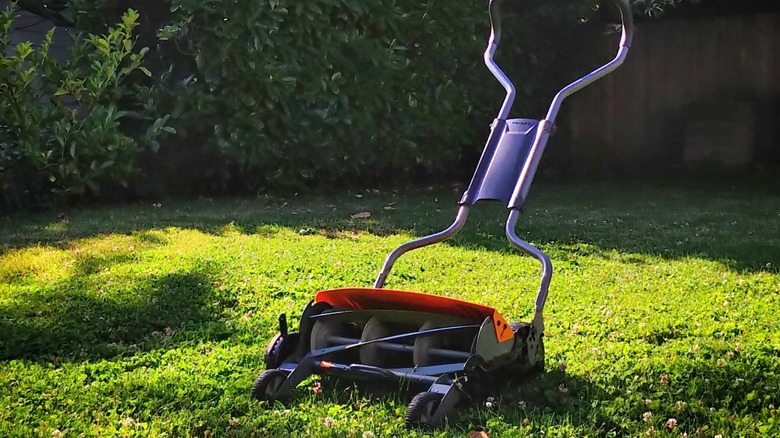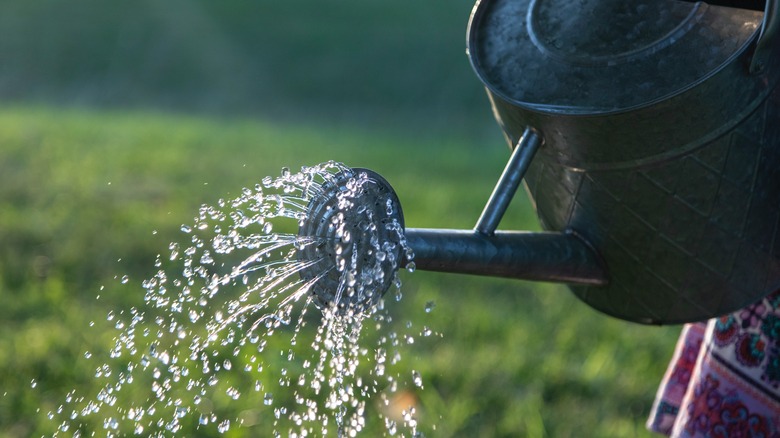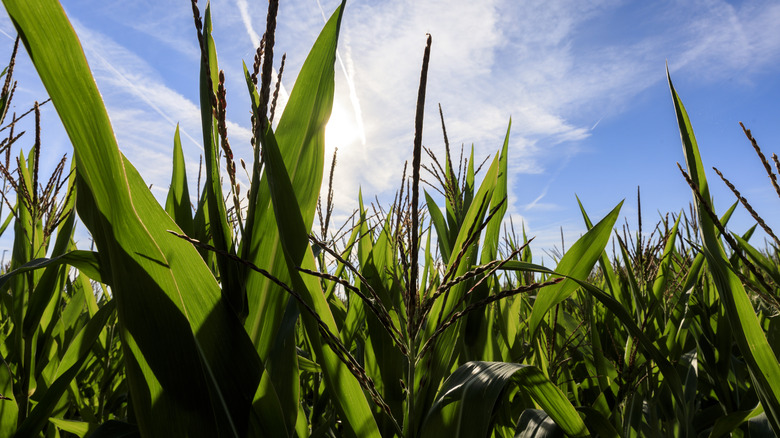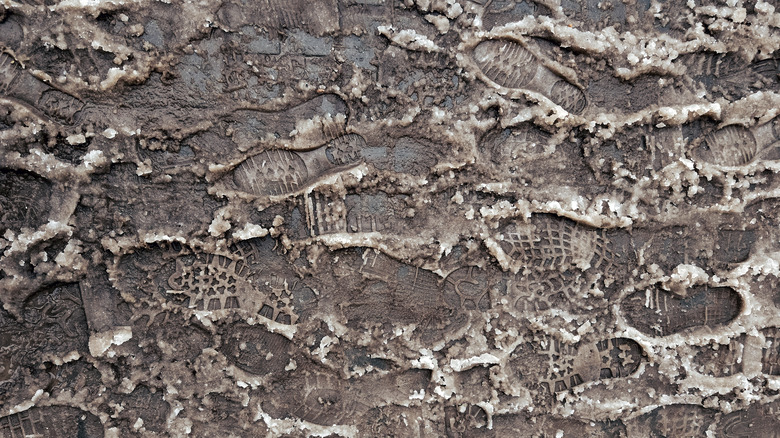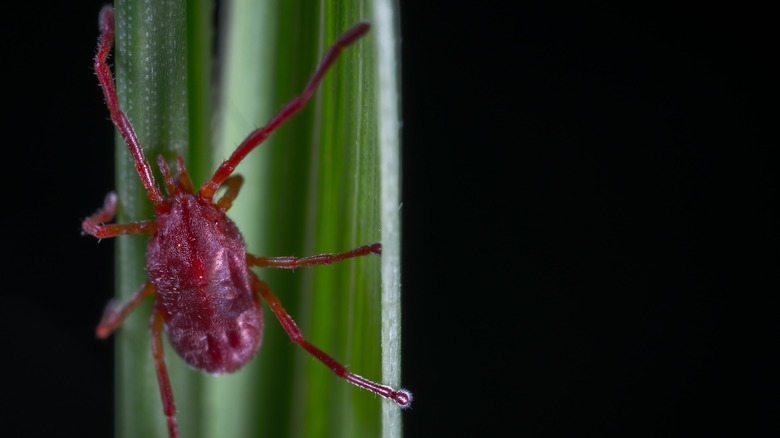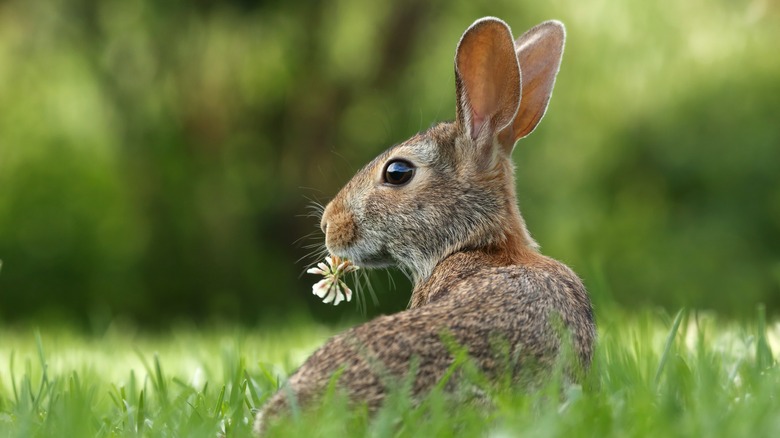Pros And Cons To Growing A Clover Yard
When discussing lawn care and maintenance, there is often a debate over what types of grass or turf work best. Many people don't realize that the simple clover plant might be the better option, as research proves its benefits as the main component of a lawn.
Clover is a crop grown to feed deer and livestock, provide simple ground coverage, and suppress weeds, according to American Meadows. However, its appeal extends beyond the quaint little flower patches, from the rich nutrients in cultivates, the low maintenance, and personal benefits. For many years clover seeds were used as a lawn standard before the development of weed herbicides in the 1950s (via Lawn Love). Whether you're looking to diversify the ratio of plants in your lawn or you've fallen under the spell of beautiful clover lawns on social media sites like TikTok and Instagram, it's essential to understand the potential advantages and disadvantages of planting clover in your lawn.
Pro: Clover is a nitrogen-fixing plant and naturally enriches your soil
Nitrogen is vital for growing plants on your lawn or garden. Since plants do not carry the ability to produce their own nitrogen, according to Think Outside the Lawn, gardeners and plant tenders have developed ways of giving nitrogen to plants through methods like manure, mulch, compost, or allowing microorganisms to flourish in the soil. Some variations of nitrogen-fixing plants convert solar energy into food for bacteria, which then take nitrogen in the atmosphere and convert it into compounds usable for plants.
Plants within the legume family are natural nitrogen-fixers. Clover's ability to fix your soil stems from the fact that this plant is a legume and often helps the nitrogen fixation process through its clippings and decay when trimmed or cut (via University of Maryland Extension). This feature was another reason clover was a natural fertilizer before the invention of herbicides. It added to the life of other turfgrass to help ensure growth.
Pro: Highly affordable alternative to grass
Those who meticulously care for their landscaping know just how expensive grass seed and turf can be. Plus, there are so many varieties to sift through before finding the perfect type or mix. While there are different clover types, there is mainly a selection of four to choose from, including Dutch White, Red, Strawberry, and Micro, per Bustling Nest. All can be used in landscaping and have similar yet unique characteristics that make them appealing to gardeners looking to spruce up their yards. Dutch White clover, for example, is an exceptionally cold-tolerant type often used to cultivate companion crops. Strawberry clover is better for wet soil. Red clover is a short-lived variety that is a tough, low-cost plant able to withstand cold winter temperatures.
Speaking of low cost, planting cover as the main or partial lawn component is more cost-effective than just using grass seed. For every dollar you spend on clover seed, you'll be able to cover about 1,000 square feet of the yard (via MindBodyGreen). Even if used only to fill out bare spots on your lawn, a cheaper alternative such as clover can help cut costs for the seed and fertilizer. Amy Cox of Pro Time Lawn Seed told Treehugger, "If you happen to plant clover with other plants, it will fertilize them as well," diminishing the need for expensive fertilizers. "That's one of the things I love about [clovers]."
Pro: Easy to manage and maintain with limited mowing
From the start, clover presents little to easy gardening prowess to get things going in your own yard. Treehugger breaks down the process into a few simple steps: decide on the seeds to plant, prepare the soil (either with or without previous grass growing), sprinkle in the seeds, water, and wait to grow and bloom. Most varieties do best planted in early spring after the last major frost, but this again depends on the type(s) chosen.
An essential aspect of growing clover is maintenance, particularly mowing, as most grass lawns need this type of care to keep everything manageable. Clover planted intentionally or in the wild does well when kept up through mowing but under a much less rigid schedule. When growing clovers to feed deer, you can cut them at least four times a year (via Midwest Whitetail). This amount is much less than many grass lawns that sometimes need trimming a few times a month. Naturally, certain varieties like Dutch White and New Zealand White Clover typically stay short (via Midwest Gardening). On the other hand, micro clovers are small leaves and lower growing, staying under 6 inches even without mowing.
Mowing clover occasionally can keep it from growing as tall, stunting its growth in height and number of leaves and blooms. Combine micro clover with traditional grass lawn because of this tendency when mowed. Even when left un-mowed, this type will not spread as aggressively or flower as much and therefore seed less.
Pro: Clover involves little-to-no fuss regarding sunlight or water
Similar to grass, clover is a plant species that can grow in most levels of sunlight, including shady, partial, or full. It all depends on the variety you choose. Unlike many grass types, clover is resilient because of its nitrogen-fixing ability. It can take nutrients deep from within the soil and not necessarily all from the sun, according to LeafyJournal. Some varieties grow best in the shade and prefer hardly any sun, including red clover and deer clover. The deer clover's ability to thrive in shady backyards and secluded natural environments makes it appealing to its animal namesake.
Other environmental needs include water and sunlight, but clover plants are relatively easygoing. When growing clover, the plants must be watered whenever the upper substrate is dry or in high heat situations (via Fertilizerfor). The watering schedule will also depend on the rainfall in your area but can range from two or three times in the summer and minimally during the winter.
Pro: Great for pet owners and farmers
Maintaining a lush green lawn can be challenging if you own one or more dogs, as the waste they leave can cause problems. Large amounts can cause dead grass patches or burns on the yard, according to Outsidepride Seed Source, LLC. Depending on how much a pet owner allows on their lawn, the results can go from being an annoying eyesore to a maintenance issue requiring additional landscaping.
Growing a clover lawn will look great as a lush green carpet. Plus, this plant can resist the effects of urine and the ugly yellow or brown patches. The plant's resilience is due to its long roots (via Bustling Nest). They take in nutrients from deep underground and are deep enough to stay unaffected by surface-level waste. Therefore pet owners can mix clovers not only to prevent dead patches but to save lawn spots already affected. Clover is also an ideal plant to cultivate if you have pets like chickens, birds, and larger livestock (via One Earth). Cattle especially enjoy grazing red clover (via the University of Michigan). Clover is known for its rich nutrient content and the ability to produce leaner meat and more nutritious milk.
Pro: Clover is ideal ground coverage
Aside from backyard aesthetics, there are some therapeutic uses of growing a clover lawn, specifically for a grounding practice. According to the National Library of Medicine, grounding, or earthing, is a therapeutic technique involving activities that ground or electrically reconnect a person to the earth. While not much research is available about this technique, theories cite that grounding affects our cells and helps stimulate growth and healing throughout the body. Ailments that this practice can help include inflammation, sleep cycles, pain reduction, and stress (via National Library of Medicine). The best way to practice grounding is to walk barefoot on the ground, dirt, or grass. You can even lie down to connect to the earth.
Alongside the many advantages, a simple benefit of clover is that the broadleaf plant is naturally softer, and its rapid pace of growth means that it covers more surface area quicker, so there are not as many bald spots or patches. Turfgrass is known for needing to be mowed more often, meaning the blades of grass can feel stubbly and irritating. However, mat-forming clover is carpet-like and soft because of the lack of mowing needed to maintain the lawn (via Leafy Place). Anyone looking to try a grounding practice will find a soft clover lawn more appealing than a stubbly, potentially sharp grass lawn.
Pro: Can be used as a beautiful and useful cover crop
Those knowledgeable of farming or gardening understand the importance, or at least advantages, of sowing a cover crop into your growth schedule. To non-gardeners or farmers, cover crops are planted before growing seasons to improve the health of the soil, kill off weeds, and help control disease, according to the Sustainable Agriculture Research & Education (SARE). These types of crops are often long-term investments. Their benefits extend further, as higher crop yields and pollinators are also associated with cover crops.
Clover is an ideal cover crop in many ways. One way is because of its excellence as a ground cover plant (via Epic Gardening). Clover grows thick and quickly across almost all varieties; white clover can grow up to 8 inches tall and rapidly spreads to cover the space and cut weeds off from light (via The Old Farmer's Almanac). This characteristic is a powerful form of weed suppression while also fighting soil erosion.
Whether grown in a garden bed or just as a whole or part of a lawn, one can use clover as a cover crop in your own backyard. Another great trait is that clover can be cut, clipped, and thrown into the soil as a type of green manure. If you're looking to boost the health of your vegetable garden or want to fertilize some indoor potted plants, growing clover on your lawn is a great way to get some added benefits.
Con: Clover is perennial so it will die in the winter
Winter is not known as a growing season, so there is usually no need to pay attention to growing or maintaining one's lawn. Just like these types of plants, clover is also a perennial species and will die when the winter months bring brisk, cold weather but come back in the spring. Grass, on the other hand, goes dormant during these months. Since it remains, there's no need for it to grow back completely in the spring, according to Think Outside the Lawn.
Clover also has a negative appeal before and after winter begins and ends, starting in the fall. At the beginning of the seasonal shift, typically late fall, clovers will become brown when entering dormancy which can look quite unappealing (via Garden Guides). Then when spring hits and the seasonal rainy weather moves in, a lack of ground coverage means mud and dirt as you wait for the clover to return. Not the most satisfying look year-round.
Con: Not the most durable plant for foot traffic
While its characteristics make it seem hearty, clover is a flexible and delicate crop. According to SelfEco Garden, a clover lawn grown from seeds needs at least two weeks before sprouts are visible, which might be challenging to do in early spring when preparing other aspects of your landscaping, including flower beds, mulching, or weeding. When sprouting, grass seeds are more durable when they shoot up. While each needs time to grow in the early stages, clover stalks that hold up their leaves are much thinner and delicate compared to blades of grass.
Although clover is not durable enough to withstand heavy foot traffic, an acceptable remedy is to mix grass seed to make it better for play or walked-on areas (via MidWest Gardening). Another potential idea is to install stone pavers around areas where clovers are growing to help you avoid stepping there. However, this can ultimately be inconvenient for an active homeowner or family looking to get their spring gardening underway.
Con: If grown alone, a clover lawn is a monoculture
If you've heard of the Irish potato famine, you can understand how heavily relying on one plant or crop without a backup plan can be dangerous. A similar problem exists when growing monoculture crops, essentially planting the same crops season after season in the same area. According to One Green Planet, this practice is ill-advised for many reasons. The main point is that by repeatedly planting the same crop in the same place, certain nutrients will deplete from the soil because of what this single crop requires. This practice has a significant effect on the farming industry as a whole.
While nutrients won't be as challenging for clover due to its nitrogen fixation, there are other issues that may arise. Growing a clover lawn seems much less high stakes because it isn't feeding an entire community of people, but having a monoculture in your own backyard can be hard to maintain if something goes wrong along the journey. If seeds get waterlogged, there's too much sun right away, or if the terrain doesn't take the seeds well, there will be no other plant to fall back on, and you'll have to start the process all over (via Think Outside the Lawn).
Con: Clovers bring clover mites, a small yet bothersome pest
If you've ever seen a tiny red bug the size of a pinhead crawling over your skin after sitting outside, you've met a clover mite. While small, they can be more trouble than you'd think. As their namesake is a clover, growing a clover lawn might mean inviting an infestation of mites into your home.
Excel Pest Services notes that clover mites are found everywhere in the United States and become more of a problem when temperatures drop outside in the fall. When cold temperatures hit, the bugs look for warm places to gather. Adult clover mites will gather on the sides of buildings and grow so bold as to crawl through cracks and small openings to find food sources, inside and out. Excess clover on your lawn can naturally make your home susceptible to mite infestations. Although these bugs are not necessarily dangerous from bites or injury, they can stain clothing, furniture, and products and damage your grass or lawn. Preventing these mites can also be troublesome. While experts recommend sealing up any visible cracks and points of entry, this task can be nearly impossible due to the small size of these bugs. Pest control services are advisable if there's an infestation, which can be another costly hassle to endure.
Pro & Con: Clovers attract pollinators and wild critters
A lush green lawn is attractive to many onlookers, but a clover lawn is especially appealing to more than humans. Clover plant varieties are excellent nectar sources for natural pollinators such as bumblebees and butterflies. Clovers are regarded highly amongst beekeepers as an essential honey plant, according to Frank Pellett, author of "American Honey Plants," per Horizontal Hive. Other creatures are known to be fans of feasting on clovers, from simple songbirds and Canadian geese to larger prey and predators like whitetail deer. You can attract deer to your garden with clover. The American black bear loves chowing down on the flowers, leaves, and seeds (via Illinois Wildflowers).
Avid wildlife lovers will relish the opportunity to feed natural pollinators and native wildlife by growing a clover lawn. Especially if you're looking to boost your own garden crops, the help of pollinators is a big bonus. However, growing clover might not be as appealing for those who are allergic to bees or want to avoid wild animals roaming their lawn, especially if they are as large as a black bear.
